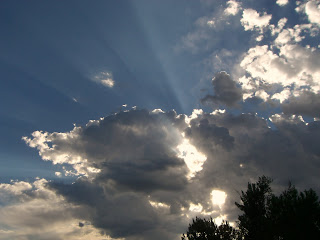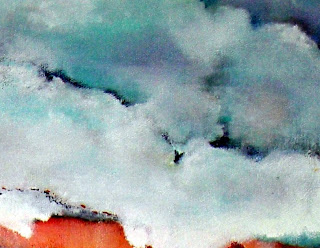New color books on my bookshelf and a few older ones helped me prepare for a new fiber project. Color books speak a different perspective on choosing a color palette, helping me define a new project in color choices I don't usually gravitate to.
Taking one of my oil paintings in purples, blues and greens and going to the color wheel for assistance, new yarn was purchased to make an afghan of granny squares. This is ambitious as 18 skeins of yarn were purchased from
Knit Picks.
Identifying the colors in the painting, I found these yarns at Knit Picks online.
On the color wheel, complementary colors are directly across from one another in the circle. Example: choosing the color red, its complementary color is green. Split Complementary Colors are "one off" from the opposite color. The split complements of red are the two colors on either side of the complementary color. Using this information, playing with the colors in making yarn selections opens up a whole new world from simply choosing one or two of your favorite colors for project work.
Here are the two books that I will be referencing to make the afghan from those 18 yarn skeins. It will never be boring as there are 200 patterns, all the same size, that will keep this handwork ever changing.
The first book,
200 Crochet Blocks, is a gem.
First, the good: all of the blocks are designed to be the same size, so you can mix and match them as you please. This is a considerable help. I have a number of vintage crochet-block books from the 60s and 70s, and none of the blocks are the same size, so it takes a lot of tweaking for each block if you want to make an afghan.
Not so when starting from scratch, making each square the same dimensions and allowing for a uniform size.
The second book, Knitter's Yarn Palette, had a fun color wheel made of yarn to illustrate the use of the color wheel when choosing yarns:
Webs has this explanation of
Knitter's Yarn Palette on its website:

This unique book explains everything there is to know about weight, gauge, texture, and the suitability of mixing yarns using a wide range of 30 projects that revolve around 10 themes including: Seashores, delicate shades of sky and sand, string, cotton, and linen yarns, ripple-effect techniques. Lazy Meadow, grassy green, poppy red, buttercup yellow, soft, silky, velvety yarns, ruffling and layering techniques. Tribal Adventure, earth tones, linen, wools, and felted yarns, felting techniques.
The washable and soft woolen yarns are a feast to the eyes and will definitely brighten up the coming dark winter days as I work with them.









































